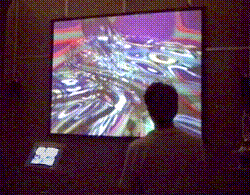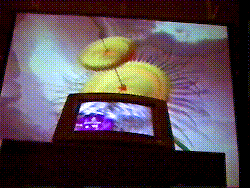TURBULENCE
an interactive museum of unnatural history
© 1994 Jon McCormack.

Still from the premiere exhibition of Turbulence at Siggraph 94, Orlando,
Florida, USA.
ARTIST STATEMENT : TURBULENCE
Jon McCormack, 1994.
The space made possible, made visible, by computers has become one of the great uncharted spaces still left for humans to explore. It has so much and so little in common with the world we find ourselves in. Using the computer, I have seen many unimaginable things, just as fascinating as any natural scene or any great painting. This work aims not only to explore the new worlds made visible by computers, but to reflect on the consequences of what these new spaces might mean to us.
All the time the speed of computers, their complexity, and that of their software – is expanding. The full version of this work took over three years to complete, much of the time spent waiting on the machine to complete its calculations. In a few years time what took years will be possible in seconds. This does not discourage me. What is important is process: the exploration, the insight, and the augmented awareness that ensues from travels into logical space of the machine.

While people may view this work as one representing beauty and a reflection of the magnificence of nature, by far the more serious notion that the work seeks to express is that of loss. In a strange and tragic way, this work is yet another turning point that marks the expedited loss of nature and the wild from ourselves.
Before Darwin's publication of The Origin of Species, the relation between humans and nature was very different than it is today. Nature inspired conquest, the wild was created to be conquered, but at the same time its power respected. A large proportion of any culture's mythology in the pre-Darwinian days related to nature and landscape. Darwin's theory rendered useless the notions of conquest and of respect – we are a product of nature, not superior to it.
Nowadays we view nature with a very different eye. Wilderness no longer holds the myth nor the beauty that it once did, except from the superficial perspective of the travel brochure. Nature is analysed, predicted, captured and synthesised. This view has shifted our self-interest from within to without. Conservation of naturally significant areas reduces to a collective cry of help for the inner self-interest which has been so wantonly destroyed for the sake of greed, progress and political expediency. We are aesthetic creatures who have a need for landscape, but as we increasingly obliterate natural environments our only alternative is to try to reinvent nature, and to synthesise it. We humans live within a narrow band that tries to order chaos, but will not accept complete order. Surely there is something sublime in this, which seems to be a fundamental property for life? But as Darwin reminds us, "a dog might as well speculate on the mind of Newton".
I have little doubt that provided we can continue beyond extinction (not a sure possibility), our environmental culture will become increasingly made. I see these computer landscapes and the artificial nature heralded by this work, as the future aesthetic replacements for the spaces that we now so fruitlessly destroy for no real purpose but short-term luxury and to sustain ever-increasing population and productivity. Despite all these changes, we have yet to really come to grips with the profound philosophical message of evolution.
I am sad for this loss of real landscape, and naturally, most people will be. But the less anthropocentric view holds that sadness, morality, pride and beauty are only human concepts. Nature, in the Victorian view, "red in tooth and claw" continues on: automatic, oblivious and inevitable.
[ Turbulence Main Page | Images | Art Projects | Main Page ]